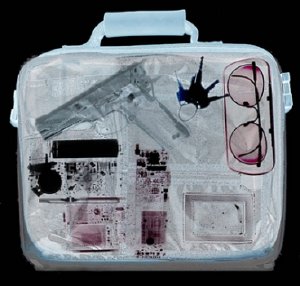Dec 8 2009
MIT researchers have developed a new way to tune the frequency of lasers that operate in the terahertz spectrum. The result is an important step toward airport scanners that could tell whether a vial in a closed suitcase contains aspirin, methamphetamines or an explosive.

Tucked between microwaves and infrared rays on the electromagnetic spectrum, terahertz rays can penetrate clothing, plastic, and human tissue, but they're thought to be safer than x-rays. Since they're absorbed to different degrees by different molecules, they can also tell chemicals apart. But accurately gauging an object's chemical composition requires exposing it to a continuous range of terahertz frequencies, which interact with it in different ways.
In a paper appearing in the most recent issue of Nature Photonics, Qing Hu, a professor of electrical engineering at MIT's Research Laboratory of Electronics, and his colleagues describe the first practical method for tuning terahertz quantum cascade lasers, a type of laser considered the most promising source of terahertz radation. What's more, the method is a fundamentally new approach to laser tuning that could have implications for other emerging technologies.
How they did it: Tuning a laser usually requires either changing the length of its light-emitting cavity or changing its temperature. Hu compares these two approaches to changing the pitch of a guitar string by pressing down on it - changing its length - or screwing its tuning peg - changing its tension. Neither approach, however, works very well with terahertz quantum cascade lasers.
A third way to change the pitch of a guitar string, however, is to change its diameter: the lower-pitched strings on a guitar are thicker than the higher-pitched ones. And Hu's tuning technique is, roughly speaking, to change the diameter of the light beam.
A light beam confined in, say, an optical fiber or a long, thin, quantum cascade laser exhibits an electromagnetic-field pattern called a "transverse mode." The transverse mode is kind of like another electromagnetic wave that's perpendicular to the light beam, except that unlike a light beam, it dies off very quickly.
Hu's new tuning technique requires a particular type of quantum cascade laser called a wire laser, where the wavelength of the transverse mode is actually greater than the width of the laser itself. Bringing a block of another material close enough to the laser deforms the transverse mode, which in turn changes the wavelength of the emitted light. In experiments, Hu and his colleagues found that a metal block shortened the wavelength of the light, while a silicon block lengthened it. Varying the proximity of the blocks also varies the extent of the shift.
Next steps: In its experiments, Hu's group used a mechanical lever to bring a block of either silicon or metal close to a quantum cascade laser from a single direction. But they've designed and are now building chips that would use electronically controlled microelectromechanical devices to bring the silicon and metal blocks in from different directions, giving the laser a precise and continuous tuning range from short to long wavelengths.